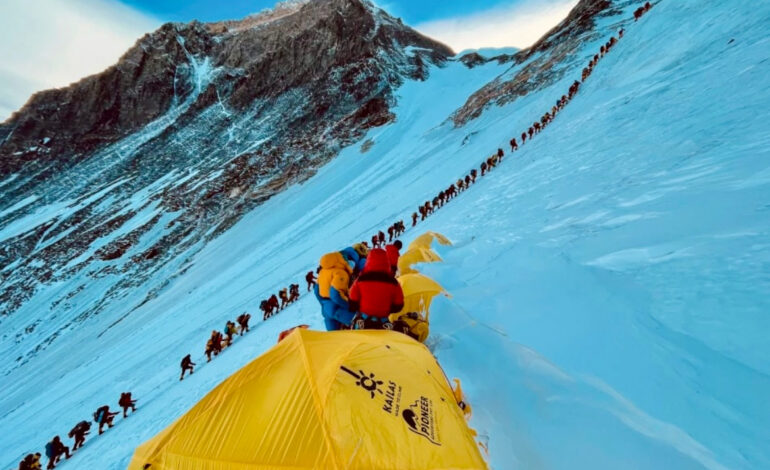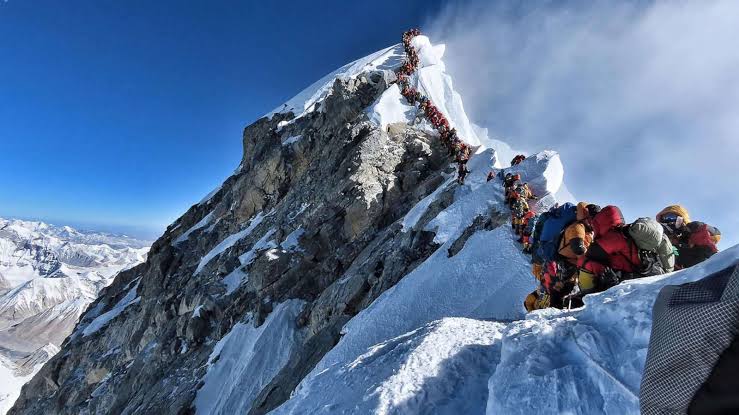
Faith Nyasuguta
It’s a dream of many adventurers to conquer Everest and see the world from the top but the risks are undeniable, and unfortunately, there have been fatalities.
The recent death of Kenyan climber Cheruiyot Kirui during his quest to summit Mount Everest has also sparked discussions on the dangers of such an expedition.
Cheruiyot embarked on a daring mission to reach the summit of Mt. Everest without supplemental oxygen. Tragically, his body was found a few meters below the summit on Tuesday.
“His indomitable will and passion for mountaineering will forever be an inspiration. We extend our heartfelt condolences to his family and friends during this time of sorrow.”
Cheruiyot, a banker by profession, had climbed Mt. Kenya 15 times. His loss is particularly painful for the families and friends of mountaineers, as the bodies of those who perish on Everest are often never retrieved.

Mount Everest, the world’s highest mountain summit (8,848.86 meters above sea level) located in Nepal and Tibet, is one of the deadliest mountains in the world. The mountain holds final resting memories for climbers who do not make it home.
Most climbers take on the mountain from Nepal, a process that involves a 10-day trek to base camp. They have to go through an acclimatization process to adjust their lungs to the thinning oxygen levels once they arrive on the mountain.
This often involves traveling upward to one of the four designated camps on the mountain and spending one to four days there before traveling back down.
Climbers repeat this routine at least two times for their bodies to adapt to declining oxygen levels and increase their chances of survival and summiting.
There have been 11,996 total Everest summits from 1922 to 2023, according to the Himalayan Database, which compiles records of all expeditions in the Himalayas.
More than 327 people are known to have died on the mountain.
In 2023 alone, 12 climbers were confirmed to have died on the mountain, with an additional five unaccounted for.
The database shows that last year saw 655 total summits.
Most climbing of Everest and the Himalayas is done in April and May when weather conditions are most favourable. It is a tedious process which requires months, sometimes years, of training and conditioning.

According to Ultimate Kilimanjaro, mountaineers on Everest face extreme cold, dangerously low oxygen levels, and inhospitable conditions.
In this ‘death zone’, the air is extremely thin, temperatures are below 0°C and the high winds are powerful enough to blow a person off the mountain.
Climbers face high-altitude cerebral edema (HACE), where one’s brain is starved of oxygen.
This results in brain swelling, causing drowsiness, and trouble speaking and thinking. One might also experience blurred vision and episodes of delusion.
The high-altitude environment and extreme conditions pose significant obstacles to recovery operations. Moving frozen bodies, which can weigh over 300 pounds (136 kg), is highly inefficient, impractical, and dangerous.
Helicopters can sometimes aid the recovery process, but the highest elevation at which they can reliably land is Camp 2, located at 21,000 feet (6,400 meters). Above this altitude, there are not enough air molecules for the rotors to create sufficient lift. The highest helicopter rescue on Everest was at 25,590 feet (7,800 meters) in 2013, under calm weather conditions.
These conditions, coupled with the high cost of body recovery, make it impossible for most families to retrieve the bodies of their loved ones. The costs associated with recovery missions on Everest can be prohibitive, requiring substantial resources and expertise. While some bodies have been identified and relocated for various reasons, the majority of fallen climbers remain on the mountain where they died.

Here are a few things that happen if one dies on Mount Everest:
- Sherpa Rescuers: A team of 18 sherpas is responsible for retrieving the bodies of deceased climbers. The mission is highly challenging, with half the team transporting essential equipment and the other half respectfully handling the bodies downhill.
- Costly Recovery: Bringing back bodies from Everest can cost over $600,000 (INR 50,050,259), making it an expensive endeavor.
- Difficult Process: High-altitude body recovery is extremely dangerous due to the harsh conditions and thin air, which hinder rescue operations.
- Frozen Remains: Bodies on Everest often freeze quickly in the sub-zero temperatures, preserving them for years or even decades.
- Legal Considerations: Managing fatalities on Everest is complex, involving multiple countries and authorities, which complicates the determination of responsibility and coordination of recovery efforts.
- Closure for Families: Families of climbers who die on Everest often face devastation and struggle to find peace and resolution without the remains of their loved ones.
The northeastern ridge route below Everest has been named the Rainbow Valley, associated with the colorful down jackets of fallen climbers strewn across its landscape. Ultimate Kilimanjaro estimates that of those that have died climbing Mount Everest, approximately 200 bodies are still on the mountain.
The tragic deaths of adventurers highlight the perilous nature of high-altitude mountaineering. Despite the risks, his passion and determination will continue to inspire others in the mountaineering community.

Their legacies serve as a poignant reminder of the ultimate sacrifices made by those who pursue the world’s highest peaks.
RELATED:




